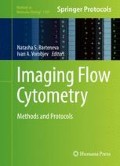Abstract
The ability to enumerate, classify, and determine biomass of phytoplankton from environmental samples is essential for determining ecosystem function and their role in the aquatic community and microbial food web. Traditional micro-phytoplankton quantification methods using microscopic techniques require preservation and are slow, tedious and very laborious. The availability of more automated imaging microscopy platforms has revolutionized the way particles and cells are detected within their natural environment. The ability to examine cells unaltered and without preservation is key to providing more accurate cell concentration estimates and overall phytoplankton biomass. The FlowCam® is an imaging cytometry tool that was originally developed for use in aquatic sciences and provides a more rapid and unbiased method for enumerating and classifying phytoplankton within diverse aquatic environments.
Access this chapter
Tax calculation will be finalised at checkout
Purchases are for personal use only
References
Sieracki CK, Sieracki M, Yentsch CS (1998) An imaging-in-flow system for automated analysis of marine microplankton. Mar Ecol Prog Ser 168:285–296
Utermöhl H (1958) Zur vervollkommnung der quantitativen phytoplankton-methodik. Mitt Int Ver Theor Angew Limnol 9:1–38
Buskey E, Hyatt CJ (2006) Use of the FlowCAM for semi-automated recognition and enumeration of red tide cells (Karenia brevis) in natural plankton samples. Harmful Algae 5:685–692
See JH, Campbell L, Richardson TL et al (2005) Combining new technologies for determination of phytoplankton community structure in the northern Gulf of Mexico. J Phycol 41:305–310
Zarauz L, Irigoien X, Urtizberea A et al (2007) Mapping plankton distribution in the Bay of Biscay during three consecutive spring surveys. Mar Ecol Prog Ser 345:37–39
Spaulding SA, Jewson DH, Bixby RJ et al (2012) Automated measurement of diatom size. Limnol Oceanogr Meth 10:882–890
Álvarez E, Moyano M, López-Urrutia A et al (2013) Routine determination of plankton community composition and size structure: a comparison between FlowCAM and light microscopy. J Plankton Res. doi:10.1093/plankt/fbt069
Zarauz L, Irigoien X, Fernandas JA (2009) Changes in plankton size structure and composition, during the generation of a phytoplankton bloom, in the central Canatabrian Sea. J Plankton Res 31:193–207
Alvarez E, Lopez-Urrutia A, Nogueira E et al (2011) How to effectively sample the plankton size spectrum? A case study using FlowCAM. J Plankton Res 33:1119–1133
Jakobsen HH, Carstensen J (2011) FlowCAM: sizing cells and understanding the impact of size distributions on biovolume of planktonic community structure. Aquat Microb Ecol 65:75–87
Zarauz L, Irigoien X (2008) Effects of Lugol’s fixation on the size structure of nano-microplankton analyzed by means of an automated counting method. J Plankton Res 30:1297–1303
Dodson AN, Thomas WH (1978) Reverse filtration. In: Sournia A (ed) Phytoplankton manual. UNESCO, Paris, pp 104–107
Acknowledgements
Support for this work was provided by Bigelow Laboratory for Ocean Sciences and the J.J. MacIsaac Facility for Aquatic Cytometry. I would like to thank Harry Nelson from Fluid Imaging Technologies for providing color images for the manuscript.
Author information
Authors and Affiliations
Corresponding author
Editor information
Editors and Affiliations
Rights and permissions
Copyright information
© 2016 Springer Science+Business Media New York
About this protocol
Cite this protocol
Poulton, N.J. (2016). FlowCam: Quantification and Classification of Phytoplankton by Imaging Flow Cytometry. In: Barteneva, N., Vorobjev, I. (eds) Imaging Flow Cytometry. Methods in Molecular Biology, vol 1389. Humana Press, New York, NY. https://doi.org/10.1007/978-1-4939-3302-0_17
Download citation
DOI: https://doi.org/10.1007/978-1-4939-3302-0_17
Published:
Publisher Name: Humana Press, New York, NY
Print ISBN: 978-1-4939-3300-6
Online ISBN: 978-1-4939-3302-0
eBook Packages: Springer Protocols

